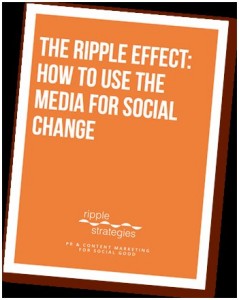For the past decade, Ripple Strategies has been harnessing the power of the media to help change-makers share their stories, create a bigger impact and leave a better legacy. They recently published a report entitled The Ripple Effect: How to Use the Media for Social Change, outlining their key experiences and learnings from over the years. SEE Change asked the co-founders of Ripple Strategies to share their top 5 takeaways. Here they are:
1: Get to Know the New Media Landscape
The worlds of print, television, and radio have collided on the Internet, allowing anyone to access all these industries have to offer at the click of a button. With this collision, the lines between traditional media and social networking have all but disappeared, leaving a new media landscape that everyone can participate in. Familiarize yourself with and take advantage of all of the communications tools at your fingertips.
2: Establish Your Voice & Authority
Today’s media landscape is a deluge of voices and content. We’ve learned that to amplify your voice and to foster the trust necessary to compel action, you need to establish authority by developing credible content, fostering credible relationships and preparing credible responses. Ultimately, for your message to be heard, believed, and acted upon, this is imperative. No matter what your passion is, it’s not just what you know that is important. It is how you promote your message, who you build relationships with, and how you respond to the world that can make or break you.
3: Ignite Conversations
With the advent of social media, all media has become dynamic. Your audience can now respond directly to your campaigns using commenting features on websites, on your social media profiles, or even just posting their opinions using their own social media channels. Anything and everything you do should be aimed at sparking this digital dialogue, which leads to “real-life” discussions, as well. It goes without saying that the more people are talking about you (in a positive way), the better; so igniting conversations should be a key element in any type of media campaign.
4: Measure Impact
People always ask us how we measure the success of a campaign, and our answer is simple: there is no standard formula for how to do it. In fact, we think measuring “success” is too narrow of an approach. Instead, we encourage measuring “impact.” Clearly it’s important to have concrete, measurable goals, but social change takes time. Limiting yourself to a narrow definition of success, or subscribing to the short-sighted, volatile metrics that permeate so much of the digital media world, can be both misleading and self-defeating. The “success vs. failure” paradigm grossly oversimplifies the many ways that social change happens. It also ignores the fact that, more often than not, the law of unintended consequences makes appearances in our work. Keep your mind and eyes open to all the diverse impacts of your efforts.
5: Refine & Repeat
Every campaign will teach you something about target audiences, messaging, and even yourself. Refine and repeat your media campaigns to continuously grow your impact. Your core mission, goals, and messages should remain consistent, but consider different ways to frame your messages. Consider different vehicles for delivering it. Consider different calls-to-action relevant to your goals. Think outside the box; embrace small experiments; and test, test, test.
The media is a powerful tool that can be used in almost infinite ways to promote social change. Check out our report for more tips, details and case studies from our last ten years helping change-makers use the media to create a better world.
——————————————————
Shayna Samuels and Glenn Turner are co-founders of Ripple Strategies, a Cause Marketing Agency based in Boulder, Colorado

